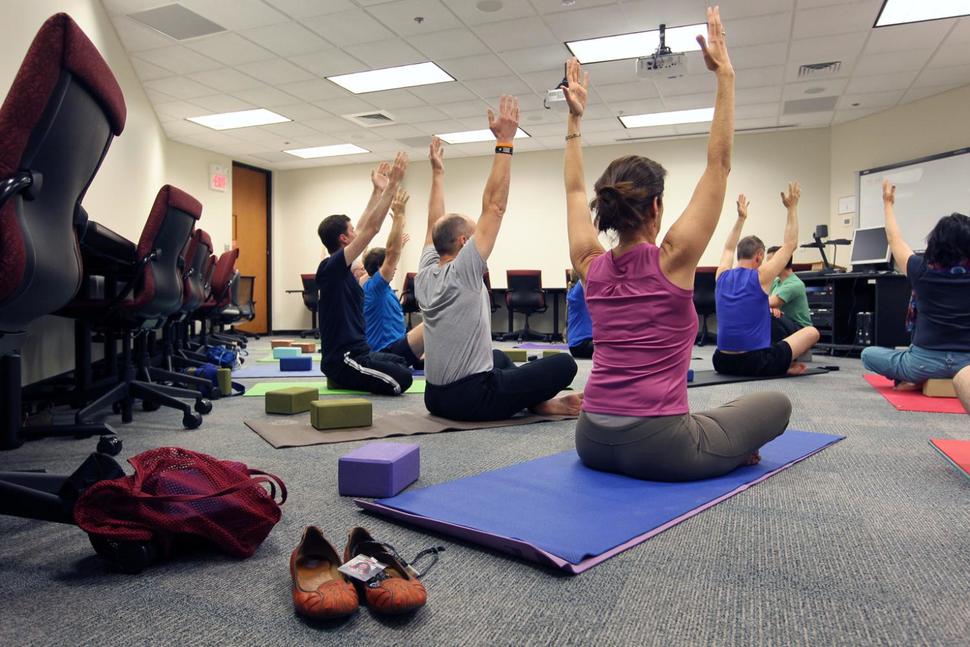Corporate wellness programs are gaining traction these days.
They have since evolved from being known as corporate wellness to corporate well-being and this is for a very good reason. In a recent survey from Careerbuilder it states that 55% of US workers say they have gained weight and 45% of them says it is from their workplace. Several factors that aid in this weight gain are sitting at the desks a long period of time, eating unhealthy, snacking and being stressed out. All these are recipes for absenteeism, presenteeism (at work but not productive) and higher medical risks which leads to higher insurance claims.
To shed a light a little on what I have found employees are now looking for when interviewing for a job. More than 3/4ths of job seekers say that benefits are very important when considering a job offer. In addition, 1/3rd of the workforce has turned down a job due to lack of benefits.
Knowing all this why wouldn’t a company want to invest in corporate wellness programs? It is actually not that easy, and though it makes sense there are things to consider and challenges that arise for having these programs in place. These are the top 5 problems in implementing a corporate wellness program and how to solve them.
1. Buy in from leadership
It is very important to have executive leadership on board with a culture that cares about the employees’ well being. Though CEOs have a bottom line to think about among so many other things, it would be more beneficial to them to understand that if their employees are well they have more productivity, less absenteeism which will help their bottom line. However, most companies are not structured that way. They believe paying for gyms or health screenings are not worth it and don’t think there is an ROI. When there is an overall healthy culture provided by executives there is more likely for participation (see #3) and this will lead to greater ROI.This is not only to CEOs or executives this is also managers and supervisors as well.
Solution: Normally larger and more established companies are easier to have buy in from the CEO, however it is up to the Human Resource Director of the company to put together a report of statistics on the benefits of the programs, costs and the ROI and VOI (value on investment) and how it will affect overall moral and ROI. It would be best to have 2-3 different programs that are relevant to the company culture and compare services, platforms and costs.
2. Costs and ROI
This one is a huge hurdle and should be tied to #1 for buy in. Many times a company does not have the budget for an expensive program and difficult to invest in a program without being able to see immediate results.
Solution: When choosing the best program or programs, success looks like overall participation, cost effective and an ROI. It is imperative for HR Director or Manager to understand employees and their background. If a small company is looking into corporate wellness program it would want to seek out more cost efficient, probably more smaller scale program. Also look at the possible savings it will have down the line by lowering insurance costs. In addition, as I referenced in above #1, there is a VOI to consider. Factors that help build a broader VOI are:
– 93% Health risk reduction
– 92% Claims health care cost reduction
– 91% Improved quality of life metrics
– 89% Increased productivity
– 84% ROI
– 84% Improved employee recruitment retention
3. Participation
Without employee participation programs will fail no matter how awesome and great they are. Without interests or even know how, programs just become a good intention but a complete failure and money drainer which is what we want to avoid at all cost (pun intended).
Solution: A wellness program is not just a transactional service or a “one and done”. With any strong wellness program you’re looking for a sustained behavior change. There are many ways that this can be done depending on the culture and size of the company. More often than not the program will have an interactive platform in place and coaching throughout. Employee engagement is critical and this can be through fitness apps, wearables/fitness trackers and contests. Give choice and flexibility to each program. Ensure the program is easy to follow and that employees know about it. Contests with incentives help keep the employee on track, but overall the program must be fun and interactive and fit in with the culture and employees’ life outside of work. One important step is for HR to be able to monitor the engagements and usage for the ROI. Make sure there is a platform to do so.
4.Technology support
There is nothing more frustrating than having several hundreds of employees all excited about starting a program or continue smashing their goals than when the platform that is used is down and there is lack of customer support to help troubleshoot. This delay can be costly and again, what we are trying to avoid.
Solution: Make sure to find a partner who will not only deliver a solution, but will also provide ongoing support via a feature like a help center. One of the most important criteria for a successful, sustainable program is supporting the end-user.
5. Right product for right company culture
As I have mentioned above, it is critical to have a program or programs that fit the culture. It would do no good if the program was high tech given to older and more blue collar employees, same as if a program centered on intervention and screenings are placed in a progressive company.
Solution: Understand the company’s business and population and develop the health and wellness strategy. Example: work-life options may be more appealing to Gen-X female workers who may also be caregivers, whereas on-site gym would appeal to Gen-Y male engineers. Communication is key as well. Create programs that target multiple health issues and explain those programs in detail through every communication channel available.
Conclusion
As obesity and diseases are on a rise and so is health insurance, corporate wellness programs are ever more important now than ever. It is understanding the company culture and different programs in place that will make a successful impact on buy-in, ROI, participation, support, and right product for the right culture. Healthy employees are happy employees!
From: Fit2BHealthe



